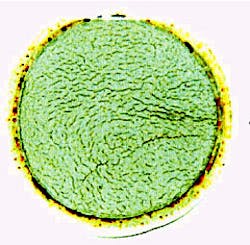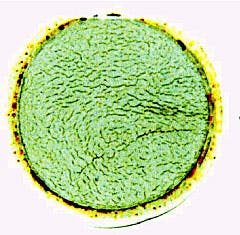Alternative methods clean up filter cake
FILTER CAKES-Conclusion
Syed Ali
Chevron U.S.A. Production Co.
New Orleans
Louise Bailey, Hemant Ladva
Schlumberger Cambridge Research
Cambridge, U.K.
Lindsay Fraser
Dowell Drilling Fluids
Houston
Cracks produced by hypochlorite on a polymer carbonate filter cake resulted in the development of high permeability for this sample (Fig. 1).New investigations into breaker-based and physical flow-back methods provide further insights into the principles of breaching filter cakes, allowing for less restricted pathways needed to increase well productivity.
This is the second in a two-part series that began Jan. 25, p. 91.
Ladva, et al., investigated chemical filter-cake cleaning methods for three commonly used water-based drill-in fluids (DIF): Polymer/sized salt, polymer/carbonate, and MMH-bentonite/carbonate systems.1
Upon acidizing the filter cakes generated from the above fluids, the bulk of the filter cake was removed in each case, leaving only clean rock in its place. Furthermore, residual influx from the acid treatments caused substantial reductions in injectivity for all samples, with the polymer/sized salt system causing the least impact on injectivity.
On subsequent return permeability testing, however, the MMH-bentonite/carbonate system gave twice the retained (return) permeability achieved by the other two systems.
The observed low and steady-state cleanup pressure helps confirm that residues created from acidizing the MMH-bentonite/carbonate cake have little potential for damaging production. By comparison, acid and polymer residues appear to have a more substantial impact.
Alternatives
To achieve efficient production in most cases, it is sufficient to increase cake permeability above a critical value rather than to remove it completely. The fact that total cake removal is not a necessity allows us to consider cleanup methods that are less aggressive than what the industry has historically considered to be essential.Specifically, alternatives to hydrochloric acid (HCl) treatments must be considered in regard to the damaging effect HCl can have through the generation of residues and the corrosive effect on completion assemblies.
In a further study on conventional external breakers, HCl was compared to alpha amylase enzyme, sodium hypochlorite, and a mixture of ammonium persulfate, ferrous sulfate, and citric acid for effectiveness in increasing the cake permeability. The acids primarily target the carbonates while the other breakers specifically target polymers.
Hypochlorite achieved the most dramatic increase in cake permeability with the two polymer-based DIF cakes (Fig. 1) while HCl was most effective with the filter cake from the MMH fluid. In all these successful cases, the cake permeability increased from the microdarcy range to values several orders of magnitude higher.
This is contrary to Chevron U.S.A. Production Co.'s laboratory and field results, which indicate that the HCl and sodium perborate breaker combination is very effective in removing polymer-sized salt and polymer-carbonate DIF filter cakes.2
Additional work carried out at Chevron's Drilling Technology Center in Houston suggests that simpler starches may be more easily cleaned up than those that are cross linked and derivatized.
Drill-solids loading may play a key role in determining the effectiveness of wash treatments. Ladva's work showed that the effect of acid and oxidative breakers is increasingly hindered by increased solids loading. Likewise the effectiveness of the enzyme breaker declined as the drill solids content increased, thus emphasizing the need for good solids-control practice during drilling.
Physical methods
The sand-control completion, whether or not gravel packed, commonly represents the last hurdle to overcome in the process of conveying hydrocarbons to surface. Sand-control assemblies are simply filters designed to arrest back flow of formation particles so that hydrocarbon fluids may pass unhindered.By nature, filters are prone to plugging and many of the open-hole production failures are attributed to blocked sand control filters. Browne, et al., studied the effect of flowing back whole oil-based fluids through screen assemblies. Although the scenario is somewhat removed from the main focus of this article, it is potentially relevant.3
They found that solids loading and particle size distribution affect screenability (filtering effect). High solids loading was considered to cause what they described as a "log jam." They adopted an approach that used a calcium carbonate grind with a single digit, d50, adequate for bridging the formation while being fine enough to flow back through the prepacked screen assembly and 20/40 resin-coated gravel.
Operationally, these workers went to great lengths to ensure that screens were never exposed to solids of a size likely to cause blockages.
Lau and Davis also carried out studies in this area and extended the work into the realm of flowing back filter cakes and residues from treatment of same.4 As far as fluid flow back is concerned, they found occurrences of blocking to be associated with the size relationships existing between pores in the completion assembly and the solids in the fluid itself.
When the d50 for the solids exceeded one seventh the size of the pore opening, blocking was considered to be almost assured. This finding is broadly consistent with Ladva's conclusion on effective bridging sizes for a given pore size.
In cases where carbonates were used, a combination of acid soaks and sweeps was found to be successful in correcting a variety of problems. However, unblocking of prepack screens was not achieved using this method.
Flowing back of the filter cake appeared to cause less damage than what occurred from contact with whole solids-laden fluid. Pretreatment of the cake with acid did appear to increase the damage to the screen when the residue was flowed back.
A balance must therefore be found between the benefits accruing with respect to reservoir remediation and the deleterious effect on completion permeability. The deliberations must include an estimate of the blocking level of the screen assembly, which can be tolerated before production is hampered. The authors included a useful table in their paper that proposes major pros and cons of the various screen types available in the marketplace.4
Ladva, et al., used a small-scale test apparatus to study the principles involved in screen blockage resulting from flow back of residue derived from the filter cake.1 Reference to the schematic of the apparatus will enlighten the reader as to the procedure followed (Fig. 2 [65,861 bytes]).
First, a cake was laid down against a porous plug, representing the formation. Subsequently, this cake was, in some cases at least, subjected to a wash fluid before residues were flowed back through a section of screen assembly.
The three DIF types discussed earlier-polymer-sized salt, polymer-carbonate, and MMH-bentonite/carbonate-were investigated. All were contaminated with drill solids having a d50 of about 10 microns. A range of screen coupons, representing commonly used field designs, were used and included resin-coated prepacks, wire wraps, and metal fiber screens.
As was the case in the study by Lau and Davis,4 all the screen types plugged easily on exposure to whole fluid, in this case with application of differential pressures as low as 5 psi. After a sufficient amount of acid (designed to dissolve all the carbonate and salt) was applied to the filter cakes, the "well" was flowed back with no evidence of significant blocking in any of the screen coupons.
This is somewhat contradictory to what Lau and Davis observed. The implication here appears to be that if the fluid can be circulated and cleaned up to eliminate particles of a potentially blocking size, and if the cake can be comprehensively degraded, the potential for screen damage resulting from filter cake residue is small.
Nonacidized cakes were also found to cause negligible screen plugging since the bulk of the cake remained on the core during flow back. In fact, the indications were that damage to the formation was more likely to be the "Achilles' heel" of the process rather than screen plugging, so long as the previously mentioned precautions were taken.
References
- Ladva, H.K., Parlar, M., Price-Smith, C., Fraser, L.J., and Ali, S.A., "Mechanisms of Sand Control Screen Plugging from Drill-In Fluids and its Clean-Up Using Acid, Oxidizers, and Enzyme Breakers," SPE paper 39439, presented at the SPE International Symposium on Formation Damage Control, Lafayette, La., Feb. 18-19, 1998.
- Price-Smith, C., Bennett, C., Ali, S.A., Hodge, R.M., Burton, R.C., Deem, C.K., Winters, W.J., and Parlar, M., "Open-Hole Horizontal Well Clean-Up in Sand Control Completions: State of the Art in Field Practice and Laboratory Development," SPE paper 50673 presented at the European Petroleum Conference, Hague, The Netherlands, Oct. 20-22, 1998.
- Browne, S.V., Ryan, D.F., Chambers, B.D., Gilchrist, J.M., and Bamforth, S.A., "Simple Approach to the Clean-Up of Horizontal Wells with Pre-Packed Screen Completions," SPE paper 30116 presented at the European Formation Damage Conference, The Hague, The Netherlands, May 15-16, 1995.
- Lau, H.C., and Davis, C.L., "Laboratory Studies of Plugging and Clean-Up of Production Screens in Horizontal Wells," SPE paper 38638 presented at the SPE Annual Technical Conference and Exhibition, San Antonio, Oct. 5-8, 1997.
Copyright 1999 Oil & Gas Journal. All Rights Reserved.

